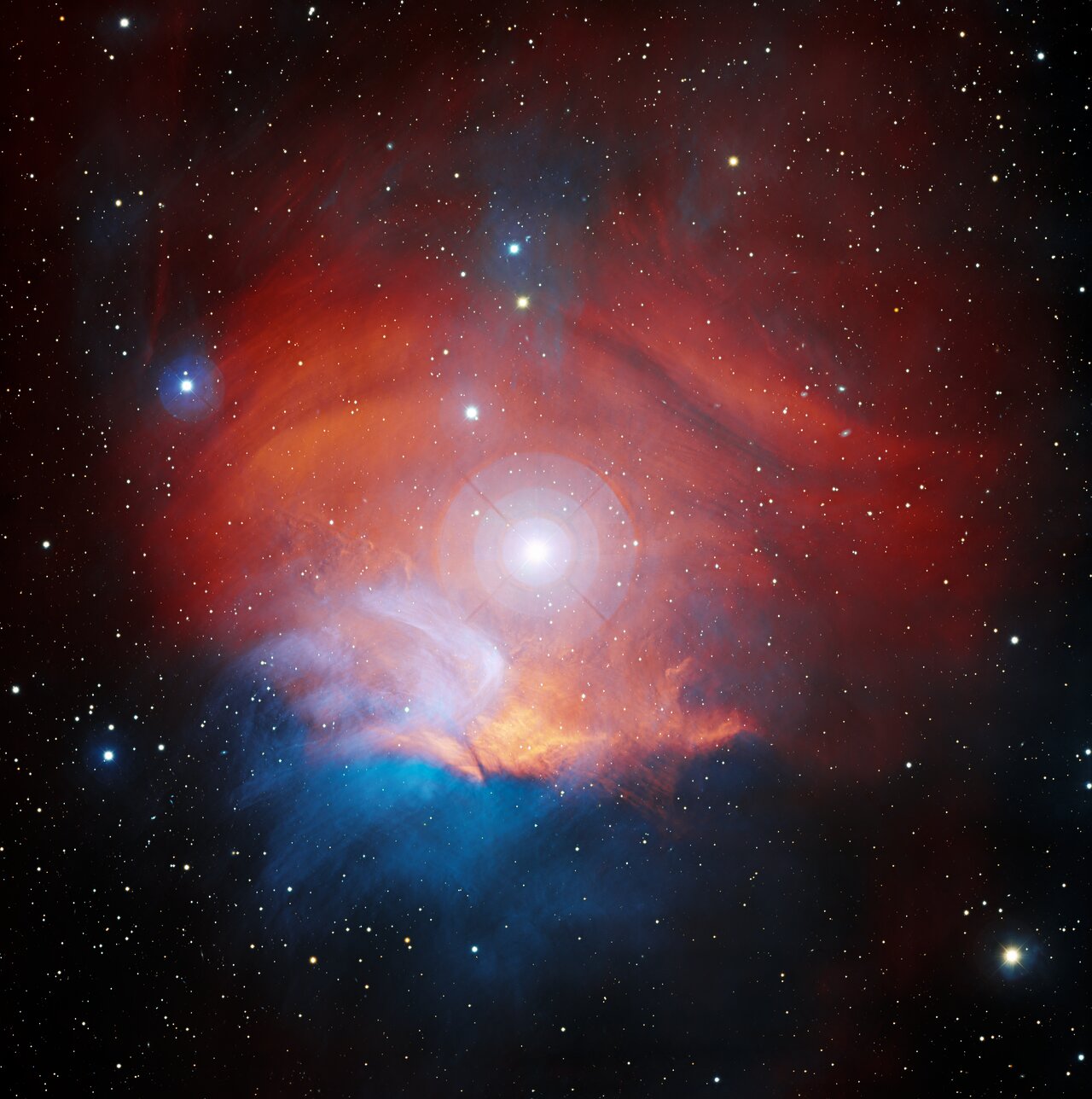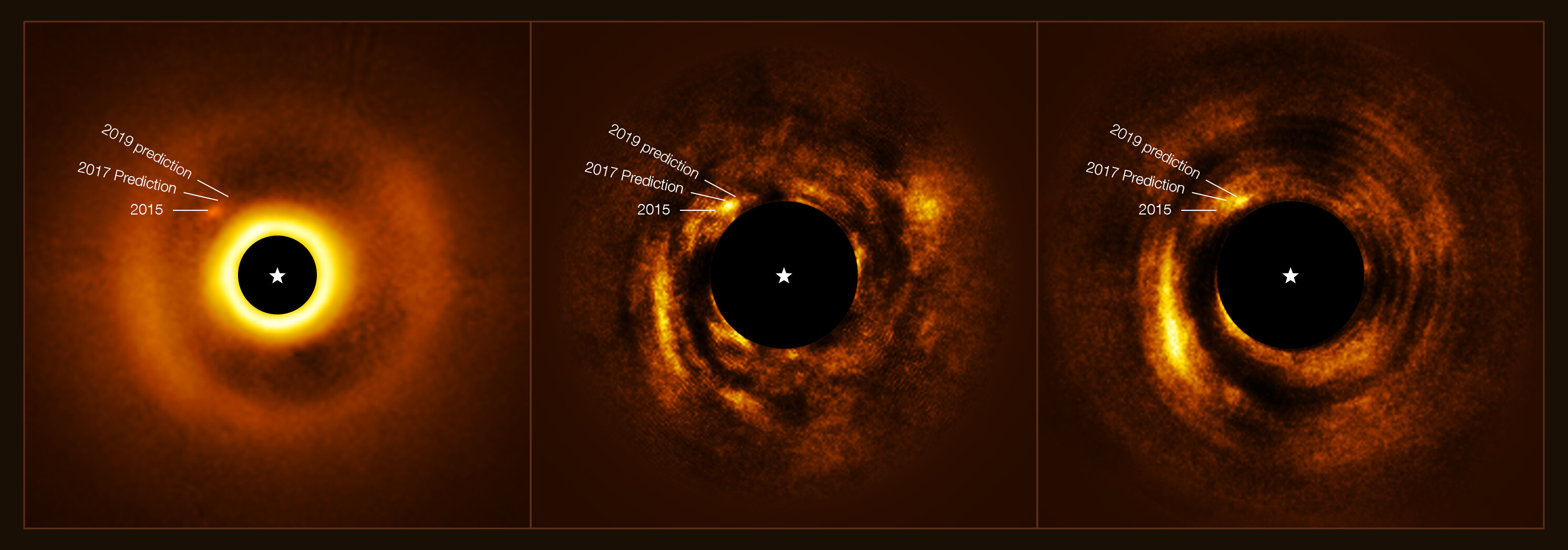StDr 16
https://www.astrobin.com/dejxuz/
Copyright: Eric Coles
Found Images: 2023 April
-
starsurfer
- Stellar Cartographer
- Posts: 5337
- Joined: Thu Mar 15, 2012 7:25 pm
NOIRLab: Nebular Harvest (LBN 867)
Nebular Harvest
NOIRLab Image of the Week (KPNO) | 2023 Apr 19
NOIRLab Image of the Week (KPNO) | 2023 Apr 19
Observing the night sky has never been so delightful as with this image of LBN 867, the Raspberry Nebula. Captured here by the Nicholas U. Mayall 4-meter Telescope using the Mosaic-3 detector at Kitt Peak National Observatory (KPNO), a Program of NSF’s NOIRLab, this nebula is located in the constellation Orion. LBN 867’s overall structure, though, is more like an onion than a raspberry: it hosts three different celestial objects in one! The characteristic red bloom of LBN 867 is an emission nebula. It glows as a result of the ionization of hydrogen gas by the light from the star HD 34989. From the center of the image, this main sequence star shines prominently, though it is about as bright as the planet Uranus as seen from Earth. The last object is hidden in plain sight. Notice the subtle bluish glow around HD 34989? This is the reflection nebula vdB 38, which reflects the blue-white light of its host star off local interstellar dust. Combined, the nebulae and star become a cosmic treat for any keen astronomer.
Know the quiet place within your heart and touch the rainbow of possibility; be
alive to the gentle breeze of communication, and please stop being such a jerk. — Garrison Keillor
alive to the gentle breeze of communication, and please stop being such a jerk. — Garrison Keillor
ESO: A New Planet Is Born (HD 169142 b)
A New Planet Is Born
ESO Picture of the Week | 2023 Apr 24
Confirmation and Keplerian motion of the gap-carving protoplanet HD 169142 b ~ Iain Hammond et al
ESO Picture of the Week | 2023 Apr 24
This Picture of the Week shows a newly-formed planet with a mass similar to Jupiter’s orbiting the star HD 169142. The star has a disc around it, and as the protoplanet moves it carves a circular gap in the disc, as seen in the first image. But how was this planet found?
Astronomers observed the system over several years with the SPHERE instrument at ESO’s Very Large Telescope in Chile. A new re-analysis of this data, led by Iain Hammond from Monash University in Australia, confirmed the presence of this protoplanet, which moves around the star at a distance somewhat larger than that between Neptune and the Sun. They also identified a spiral wake that the protoplanet leaves behind as it rearranges part of the material in the disc, much like a boat can create a wake as it moves through water.
A protoplanet forms during the early stages of a planetary system. It grows as it accretes dust, gas, rocks and other materials that surround its host star, clearing its orbit and creating gaps like the one seen here. The SPHERE instrument is specifically designed to observe these features, blocking light from the star to increase the contrast in the image, and correcting the blur caused by atmospheric turbulence to improve the resolution. By studying the spiral wake and the gap that the protoplanet has created around the star HD 169142, astronomers can learn more about how giant planets such as Jupiter form.
Confirmation and Keplerian motion of the gap-carving protoplanet HD 169142 b ~ Iain Hammond et al
- Monthly Notices of the RAS: Letters 522(1):L51 (June 2023) DOI: 10.1093/mnrasl/slad027
- arXiv > astro-ph > arXiv:2302.11302 > 22 Feb 2023 (v1), 23 Feb 2023 (v2)
Know the quiet place within your heart and touch the rainbow of possibility; be
alive to the gentle breeze of communication, and please stop being such a jerk. — Garrison Keillor
alive to the gentle breeze of communication, and please stop being such a jerk. — Garrison Keillor
ESA: The Cluster That Almost Got Away
The Cluster That Almost Got Away
ESA Hubble Picture of the Week | 2023 Apr 24
ESA Hubble Picture of the Week | 2023 Apr 24
A menagerie of interesting astronomical finds fill this image from the NASA/ESA Hubble Space Telescope. As well as several large elliptical galaxies, a ring-shaped galaxy is lurking on the right of this image. A pair of bright stars are also visible at the left of this image, notable for their colourful criss-crossing diffraction spikes. This collection of astronomical curiosities is the galaxy cluster ACO S520 in the constellation Pictor, which was captured by Hubble’s Advanced Camera for Surveys.Image Credit: ESA/Hubble & NASA, H. Ebeling
- A collection of oval-shaped, elliptical galaxies. The largest has two neighbouring bright spots in the core. It and two others look like galaxy clusters, with surrounding smaller galaxies. On the left edge of the image are two bright stars with four long spikes, and on the right edge is a small ring-shaped galaxy. Smaller stars and galaxies are spread evenly across the dark background.
This is one of a series of Hubble observations searching for massive, luminous galaxy clusters that had not been captured by earlier surveys. Appropriately, the proposal for observing time was named "They almost got away"! Astronomers took advantage of occasional gaps in Hubble's busy schedule to capture images of these barely-explored galaxy clusters, revealing a wealth of interesting targets for further study with Hubble and the NASA/ESA/CSA James Webb Space Telescope.
Galaxy clusters are among the largest known objects in the Universe, and studying these objects can provide insights into the distribution of dark matter, which is responsible for most of the mass of a galaxy cluster. The vast masses of galaxy clusters is what causes many of them to act as gravitational lenses which distort and magnify light from even more distant objects. This can allow astronomers to use galaxy clusters as a kind of natural gravitational telescope to reveal distant objects that would usually be too faint to resolve — even for the crystal-clear vision of Hubble.
Know the quiet place within your heart and touch the rainbow of possibility; be
alive to the gentle breeze of communication, and please stop being such a jerk. — Garrison Keillor
alive to the gentle breeze of communication, and please stop being such a jerk. — Garrison Keillor
NOIRLab: A Cosmic Overpass
A Cosmic Overpass
NOIRLab Image of the Week | 2023 Apr 26
NOIRLab Image of the Week | 2023 Apr 26
Above the peaks of Cerro Pachón lies a bridge made of stars, intangible yet visible to the naked eye. This beautiful arch, composed of the Milky Way with its network of nebulae and interstellar clouds, seemingly connects the Rubin Auxiliary Telescope (AuxTel) (left) with the upcoming Vera C. Rubin Observatory (right), a Program of NSF’s NOIRLab. Some spectacles of the Universe dot around the Milky Way, from the Magellanic Clouds (center bottom) to the crimson emission nebulae (upper left and bottom right) to the green and red airglow on the horizon. Although it is possible to catch a glimpse of these treasures elsewhere on Earth, only in remote locations such as the highly elevated Andes can one truly bask in all their splendor.
Rubin Observatory is a joint initiative of the National Science Foundation (NSF) and the US Department of Energy (DOE). Once completed, Rubin will be operated jointly by NSF’s NOIRLab and DOE's SLAC National Accelerator Laboratory to carry out the Legacy Survey of Space and Time (LSST).
Know the quiet place within your heart and touch the rainbow of possibility; be
alive to the gentle breeze of communication, and please stop being such a jerk. — Garrison Keillor
alive to the gentle breeze of communication, and please stop being such a jerk. — Garrison Keillor



